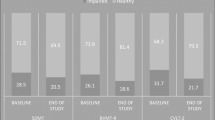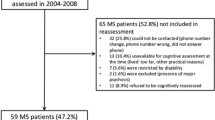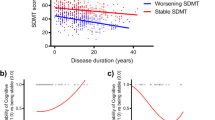Abstract
Uric acid (UA) is reduced in multiple sclerosis (MS), and possibly relates to MS outcomes, with lower UA levels in subjects experiencing a relapse or presenting higher disability scores. The present retrospective longitudinal study evaluated UA variations in MS, in relation to clinical relapses, disability progression, and cognitive functions. We included 141 subjects with relapsing–remitting MS (RRMS) and performed expanded disability status scale (EDSS), symbol digit modalities test (SDMT) and UA evaluation at baseline visit and after 2-year follow-up. Paired t test showed significantly lower UA levels after 2-year follow-up than at baseline (3.987 ± 1.135 and 4.167 ± 1.207 mg/dL, respectively) (p = 0.001). The difference in UA levels between 2-year follow-up and baseline related to EDSS sustained progression (p < 0.001; OR = 0.099), and presented a trend for clinical relapses at logistic regression (p = 0.211; OR = 0.711) and for the time to relapse at Cox regression (p = 0.236; HR = 0.792). Analysis of variance showed reduced baseline UA levels in subjects with impaired SDMT at baseline (p = 0.045; adjusted R 2 = 0.473) and after 2-year follow-up (p = 0.034; adjusted R 2 = 0.470). This is the first study showing a progressive reduction of UA levels during the course of RRMS, suggesting a progressive decrease of antioxidant reserves, in relation to relapse risk, disability progression and cognitive function.


Similar content being viewed by others
References
Schreibelt G, van Horssen J, van Rossum S, Dijkstra CD, Drukarch B, de Vries HE (2007) Therapeutic potential and biological role of endogenous antioxidant enzymes in multiple sclerosis pathology. Brain Res Rev 56(2):322–330. doi:10.1016/j.brainresrev.2007.07.005
Hooper DC, Bagasra O, Marini JC, Zborek A, Ohnishi ST, Kean R, Champion JM, Sarker AB, Bobroski L, Farber JL, Akaike T, Maeda H, Koprowski H (1997) Prevention of experimental allergic encephalomyelitis by targeting nitric oxide and peroxynitrite: implications for the treatment of multiple sclerosis. Proc Natl Acad Sci USA 94(6):2528–2533
Hooper DC, Scott GS, Zborek A, Mikheeva T, Kean RB, Koprowski H, Spitsin SV (2000) Uric acid A peroxynitrite scavenger inhibits CNS inflammation blood– CNS barrier permeability changes and tissue damage in mouse model of multiple sclerosis. FASEB J 14(5):691–698
Squadrito GL, Cueto R, Splenser AE, Valavanidis A, Zhang H, Uppu RM, Pryor WA (2000) Reaction of uric acid with peroxynitrite and implications for the mechanism of neuroprotection by uric acid. Arch Biochem Biophys 376(6):333–337. doi:10.1006/abbi.2000.1721
Scott GS, Spitsin SV, Kean RB, Mikheeva T, Koprowski H, Hooper DC (2002) Therapeutic intervention in experimental allergic encephalomyelitis by administration of uric acid precursors. Proc Natl Acad Sci USA 99(25):16303–16308. doi:10.1073/pnas.212645999
Hooper DC, Spitsin S, Kean RB, Champion JM, Dickson GM, Chaudhry I, Koprowski H (1998) Uric acid, a natural scavenger of peroxynitrite, in experimental allergic encephalomyelitis and multiple sclerosis. Proc Natl Acad Sci USA 95(2):675–680
Toncev G, Milicic B, Toncev S, Samardzic G (2002) Serum uric acid levels in multiple sclerosis patients correlate with activity of disease and blood-brain barrier dysfunction. Eur J Neurol 9(3):221–226. doi:10.1046/j.1468-1331.2002.00384.x
Toncev G, Milicic B, Toncev S, Samardzic G (2002) High-dose methylprednisolone therapy in multiple sclerosis increases serum uric acid levels. Clin Chem Lab Med 40(5):505–508. doi:10.1515/CCLM.2002.088
Dujmovic I, Pekmezovic T, Obrenovic R et al (2009) Cerebrospinal fluid and serum uric acid levels in patients with multiple sclerosis. Clin Chem Lab Med 47:848–853. doi:10.1515/CCLM.2009.192
Spitsin S, Hooper DC, Mikheeva T, Koprowski H (2001) Uric acid levels in patients with multiple sclerosis: analysis in mono- and dizygotic twins. Mult Scler 7(3):165–166. doi:10.1177/135245850100700305
Sotgiu S, Pugliatti M, Sanna A, Sotgiu A, Fois ML, Arru G, Rosati G (2002) Serum uric acid and multiple sclerosis. Neurol Sci 23(4):183–188. doi:10.1007/s100720200059
Peng F, Zhang B, Zhong X, Li J, Xu G, Hu X, Qiu W (2008) Pei Z (2008) Serum uric acid levels of patients with multiple sclerosis and other neurological diseases. Mult Scler 14(2):188–196. doi:10.1177/1352458507082143
Ashtari F, Bahar M, Aghaei M, Zahed A (2013) Serum uric acid level in patients with relapsing–remitting multiple sclerosis. J Clin Neurosci 20(5):676–678. doi:10.1016/j.jocn.2012.05.054
Drulovic J, Dujmovic I, Stojsavljevic N, Mesaros S, Andjelković S, Miljković D, Perić V, Dragutinović G, Marinković J, Lević Z, Mostarica Stojković M (2001) Uric acid levels in sera from patients with multiple sclerosis. J Neurol 248(2):121–126
Knapp CM, Constantinescu CS, Tan JH, McLean R, Cherryman GR, Gottlob I (2004) Serum uric acid levels in optic neuritis. Mult Scler 10(3):278–280
Liu B, Shen Y, Xiao K, Tang Y, Cen L, Wei J (2012) Serum uric acid levels in patients with multiple sclerosis: a meta-analysis. Neurol Res 34(2):163–171. doi:10.1179/1743132811Y.0000000074
Moccia M, Lanzillo R, Palladino R, Russo C, Carotenuto A, Massarelli M, Vacca G, Vacchiano V, Nardone A, Triassi M, Morra VB (2014) Uric acid: a potential biomarker of multiple sclerosis and of its disability. Clin Chem Lab Med. doi:10.1515/cclm-2014-0744
Guerrero AL, Gutiérrez F, Iglesias F, Martín-Polo J, Merino S, Martín-Serradilla JI, Laherrán E, Tejero MA (2011) Serum uric acid levels in multiple sclerosis patients inversely correlate with disability. Neurol Sci 32(2):347–350. doi:10.1007/s10072-011-0488-5
Euser SM, Hofman A, Westendrop RGJ, Breteler MMB (2009) Serum uric acid and cognitive function and dementia. Brain 132(Pt 2):377–382. doi:10.1093/brain/awn316
Moccia M, Picillo M, Erro R, Vitale C, Longo K, Amboni M, Santangelo G, Spina E, De Rosa A, De Michele G, Santoro L, Barone P, Pellecchia MT (2014) Is serum uric acid related to non-motor symptoms in de-novo Parkinson’s disease patients? Parkinsonism Relat Disord 20(7):772–775. doi:10.1016/j.parkreldis.2014.03.016
Poser CM, Paty DW, Scheinberg L, McDonald WI, Davis FA, Ebers GC, Johnson KP, Sibley WA, Silberberg DH, Tourtellotte WW (1983) New diagnostic criteria for multiple sclerosis: guidelines for research protocols. Ann Neurol 13(3):227–231
Lublin FD, Reingold SC, Cohen JA, Cutter GR, Sørensen PS, Thompson AJ, Wolinsky JS, Balcer LJ, Banwell B, Barkhof F, Bebo B Jr, Calabresi PA, Clanet M, Comi G, Fox RJ, Freedman MS, Goodman AD, Inglese M, Kappos L, Kieseier BC, Lincoln JA, Lubetzki C, Miller AE, Montalban X, O’Connor PW, Petkau J, Pozzilli C, Rudick RA, Sormani MP, Stüve O, Waubant E, Polman CH (2014) Defining the clinical course of multiple sclerosis: the 2013 revisions. Neurology 83(3):278–286. doi:10.1212/WNL.0000000000000560
Polman CH, Reingold SC, Banwell B, Clanet M, Cohen JA, Filippi M, Fujihara K, Havrdova E, Hutchinson M, Kappos L, Lublin FD, Montalban X, O’Connor P, Sandberg-Wollheim M, Thompson AJ, Waubant E, Weinshenker B, Wolinsky JS (2011) Diagnostic criteria for multiple sclerosis: 2010 revisions to the McDonald criteria. Ann Neurol 69(2):292–302. doi:10.1002/ana.22366
Constantinescu CS, Freitag P, Kappos L (2000) Increase in serum levels of uric acid, an endogenous antioxidant, under treatment with glatiramer acetate for multiple sclerosis. Mult Scler 6(6):378–381. doi:10.1177/135245850000600603
Kurtzke JF (1983) Rating neurological impairment in multiple sclerosis: an expanded disability scale (EDSS). Neurology 33:1444–1452
Ebers GC, Heigenhauser L, Daumer M, Lederer C, Noseworthy JH (2008) Disability as an outcome in MS clinical trials. Neurology 71(9):624–631. doi:10.1212/01.wnl.0000313034.46883
Nocentini U, Giordano A, Di Vincenzo S, Panella M, Pasqualetti P (2006) The Symbol Digit Modalities Test-Oral version: Italian normative data. Funct Neurol 21(2):93–96
Amato MP, Portaccio E, Goretti B, Zipoli V, Ricchiuti L, De Caro MF, Patti F, Vecchio R, Sorbi S, Trojano M (2006) The Rao’s Brief Repeatable Battery and Stroop Test: normative values with age, education and gender corrections in an Italian population. Mult Scler 12(6):787–793. doi:10.1177/1352458506070933
Zoccolella S, Tortorella C, Iaffaldano P, Direnzo V, D'Onghia M, Luciannatelli E, Paolicelli D, Livrea P, Trojano M (2012) Low serum urate levels are associated to female gender in multiple sclerosis patients. PLoS One 7(7):e40608. doi:10.1371/journal.pone.0040608
Van Schependom J, D’hooghe MB, Cleynhens K, D’hooge M, Haelewyck MC, De Keyser J, Nagels G (2014) The symbol digit modalities test as sentinel test for cognitive impairment in multiple sclerosis. Eur J Neurol 21(9):1219–1225. doi:10.1111/ene.12463 (e71–e72)
Moccia M, Picillo M, Erro R, Vitale C, Longo K, Amboni M, Santangelo G, Palladino R, Capo G, Orefice G, Barone P, Pellecchia MT (2015) Presence and progression of non-motor symptoms in relation to uric acid in de novo Parkinson’s disease. Eur J Neurol 22(1):93–98. doi:10.1111/ene.12533
Miller E, Walczak A, Saluk J, Ponczek MB, Majsterek I (2012) Oxidative modification of patient’s plasma proteins and its role in pathogenesis of multiple sclerosis. Clin Biochem 45(1–2):26–30. doi:10.1016/j.clinbiochem.2011.09.021
Bowman GL, Shannon J, Frei B, Kaye JA, Quinn JF (2010) Uric acid as a CNS antioxidant. J Alzheimers Dis 19(4):1331–1336. doi:10.3233/JAD-2010-1330
Niklasson F, Hetta J, Degrell I (1988) Hypoxanthine, xanthine, urate and creatinine concentration gradients in cerebrospinal fluid. Ups J Med Sci 93(3):225–232
Karg E, Klivényi P, Németh I, Bencsik K, Pintér S, Vécsei L (1999) Nonenzymatic antioxidants of blood in multiple sclerosis. J Neurol 246(7):533–539
Amorini AM, Petzold A, Tavazzi B, Eikelenboom J, Keir G, Belli A, Giovannoni G, Di Pietro V, Polman C, D’Urso S, Vagnozzi R, Uitdehaag B, Lazzarino G (2009) Increase of uric acid and purine compounds in biological fluids of multiple sclerosis patients. Clin Biochem 42(10–11):1001–1006. doi:10.1016/j.clinbiochem.2009.03.020
Rentzos M, Nikolaou C, Anagnostouli M, Rombos A, Tsakanikas K, Economou M, Dimitrakopoulos A, Karouli M, Vassilopoulos D (2006) Serum uric acid and multiple sclerosis. Clin Neurol Neurosurg 108(6):527–531. doi:10.1016/j.clineuro.2005.08.004
Muñoz García D, Midaglia L, Martinez Vilela J, Marín Sánchez M, López González FJ, Arias Gómez M, Dapena Bolaño D, Iglesias Castañón A, Alonso Alonso M, Romero López J (2014) Associated Inosine to interferon: results of a clinical trial in multiple sclerosis. Acta Neurol Scand. doi:10.1111/ane.12333
Acknowledgments
The present study received no specific funding.
Conflicts of interest
Authors declare no conflict of interest in relation to the current work.
Ethical standard
The present study received approval from the local ethics committee and has been performed in accordance with the ethical standards laid down in the 1964 Declaration of Helsinki. All patients gave appropriate informed consent.
Author information
Authors and Affiliations
Corresponding author
Rights and permissions
About this article
Cite this article
Moccia, M., Lanzillo, R., Costabile, T. et al. Uric acid in relapsing–remitting multiple sclerosis: a 2-year longitudinal study. J Neurol 262, 961–967 (2015). https://doi.org/10.1007/s00415-015-7666-y
Received:
Revised:
Accepted:
Published:
Issue Date:
DOI: https://doi.org/10.1007/s00415-015-7666-y




